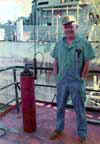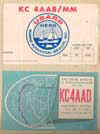|
|
|
 |
|
|
The year was 1974. I had been working and traveling abroad for 10 years. Now, after three years of heartbreaking struggle with my wifeís cancer, I awoke one morning and realized my limited savings were exhausted and I must seek employment. I returned to Long Beach , California. Needless to say things had changed considerably in the years of my absence. I examined my modest list of talents and decided to concentrate my efforts in the field of Marine Electronics. To that end I collected the publications necessary to study for the FCC examinations leading to a marine radio operator's license. I took the exams in Los Angeles and fortunately passed on the first attempt. My success was no doubt a result of my years as a ham radio operator and the training which I received while serving in the United States Air Force during WW2. I soon discovered there was a catch 22 which made it difficult to get the U.S. Coast Guard Merchant Marine Officers license which is necessary before obtaining employment aboard a U.S. Flag commercial vessel. The license cannot be granted unless the recipient has an endorsement of 6 months sea time, which of course was impossible without the license. Fortunately there was a demand for FCC licensed technicians in the Shoreside Electronic Service industry. I was able to find employment at Marine Electronics Inc. Wilmington CA. After several months of valuable experience working at the ports of Los Angeles and Long Beach, fortune took a favorable turn. A most curious looking sailing vessel arrived at the harbor and dry-docked at Al Larson's Ship Yard On Terminal Island. She had a green hull and bore the name of R/V Hero (R/V means, research vessel). and the seal of The National Science Foundation ,U.S. Gov. She was a Cutter rigged ketch built by Harvey Gammich ship yard and of a class of vessel known a New England Side trawler. I shall never forget the comment of a salty looking old gentleman after being on board years later with a tour group he turned to me as he stepped off the gangway and said "She ain't much fer pretty but she sure is hell fer stout". The government was seeking a contractor to modernize and update her communications system. After some persuasion I was able to convince Mr. Harold Romberg, Marine Radio's President, that I was the man for the job. While I was working aboard, I became acquainted with some of her crew. The sea stories they told about sailing around Cape Horn and probing into the waters around Antarctica were enough to stir the fantasies of high adventure in any red-blooded, middle aged electronics technician. As a result Captain Lennie was able to easily convince me that I should give up my steady 9 to 5 job and go sailing off to the end of the world. The peculiar tonnage range of the sailing vessel made it unnecessary to have the 6 months endorsement; just the loop hole I was looking for. Before becoming a member of the crew I was required to pass the U.S. Navyís Deep Freeze physical, one of the most rigorous imaginable. Measurements of physical strength and endurance were made and I was carefully checked by a dentist for no cavities (dental emergencies are difficult to treat on the Antarctic Continent). Soon I was underway and headed for Cape Horn. Heroís full compliment of new sails had not arrived when we departed so we were motoring south along the Mexican coast when the compound transmission connecting our two diesels to the screw locked up and left us floating miles out to sea south of the island of Sacuro. This was the first test of the new communications system which I had installed and it performed beautifully. After several attempts I contacted the Mexican Naval vessel Usamachinta. and convinced her Captain to come to our assistance. They took us in tow the following morning and moved us to a point near enough to Sacuro to anchor. When I suggested to the Captain that he might drop us off at a more convenient location, he looked at me sternly and commented, "No somos Remulcaros" (We are not a tugboat). I returned to my radio and contacted a towing company in Mexico City who dispatched a tug to our assistance. After some confusion brought about by the language barrier we were towed to the port of Manzinillo. Larsonís shipyard sent a repair crew down from Los Angeles and several days later we were under way again. I was beginning to get the feel of being a sailor and I loved it. Little did I know that this was the beginning of a new career that was to stretch over the next 30 years and take me to exotic places I had only dreamed of as a young man back in Washington PA. As we moved south toward Cape Horn I made daily radio contacts with the crew waiting at our destination, Palmer Station, on Anvers Island . Anvers is located just off the west coast of the Antarctic Peninsula and is one of the permanent stations maintained by the U.S.A. in Antarctica. They were understandably anxious since we were behind schedule about one month due to our unscheduled stop in Mexico. The crew had wintered over and were totally dependent on Hero for their relief crew and the only means of transportation out of Antarctica. I also arranged Telephone Patches back to the states for various members of Heroís crew so that they might maintain contact with their families back home. For recreation during my hours on watch I spoke to many ham radio operators around the world . One of the most notable was Tom Christian on Pitcarin Island . Tom is a direct descendant of the first mate on HMS Bounty as described in the book "Mutiny on the Bounty." Not far behind us was the 35 ft. sailing yacht "Daulphine Amical" with Donald Douglas and his wife from Long Beach Ca. onboard board (no relation to the other Donald Douglas of Douglas Aircraft Co.) They were bound for Christmas Island and eventually around the Horn. His radio was not powerful enough to stay in touch with the states so I relayed any traffic that he might have. I lost track of him after he arrived at Christmas Island but found out later that the yacht pitch poled soon after their departure from Christmas Island and that they were eventually picked up by a British Freighter near the south coast of Chile. As we approached the roaring 40ís the weather grew more intense. It became impossible to sit upright in my chair in the radio room so I found I could operate from the deck by wedging myself between the operating console and the bulkhead. Cape Horn was just ahead and as we approached I began to appreciate what the early square riggers went through back in the days before the Panama Canal. These are among the stormiest waters on earth. As we passed the cape I could see nothing but mountainous waves and heavy mist hanging on the horizon. Cape pigeons and storm petrels were the only sign of life we could see, letting us know we were near land. I was to pass this point 13 times before my 4 years working on Hero was finished. Our first scheduled stop was in Ushuaia , Tierra del Fuego. Ushuaia claims to be the world's most southerly city. It is at the north end of The Beagle Channel made famous by Darwin during his voyage on the HMS Beagle that lead to his theory of evolution. We entered the Beagle from the south with the Andes rising majestically on both sides. The calm waters were a great relief after our experience at Cape Horn. The trip up to Ushuaia took two days. We docked and went ashore. The feel of solid terra firma under our feet was a welcome relief after our voyage of nearly 8,000 miles. We explored the town and got acquainted with the sophisticated Argentine people who live in this wild, untamed land at the bottom of the earth. I later became a close friend to Tommy Goodall the owner of a sprawling estancia called Harberton. It lays along the east shore of the Beagle . Tommy grazes about a million head of sheep on the property which stretches about 50 miles to the east. He also owns an island called Los Gables which is in the middle of the Beagle. N.S.F. Leases a warehouse in Ushuaia which serves as shore side receiving point for items shipped down from the USA. We were delighted to find our new compliment of sails waiting there. Within a few days, 10 scientists arrived by air from various Universities and we were off to Antarctica and an adventure which was to last for two and one half years and consisted of 35 separate expeditions. But that is another story.- - - - - |

|
|
|
|











